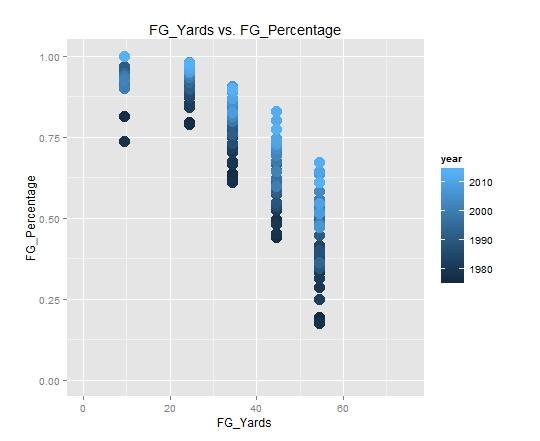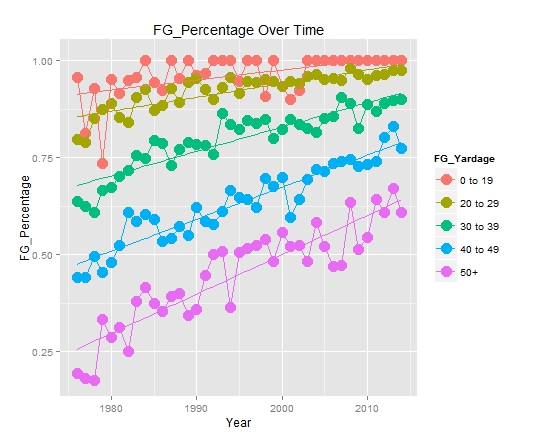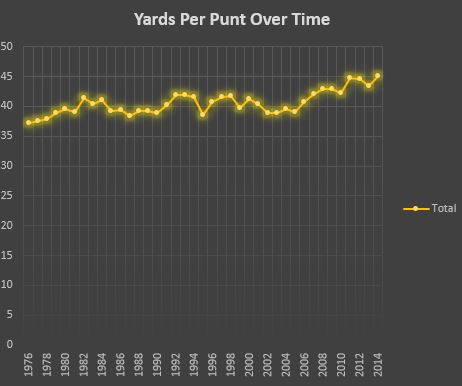Introduction
While gathering data for developing predictive models for NFL game results (see here), I have been looking into general statistics about NFL games and players. Here is a look into the history and statistics of kicking and punting in the NFL since 1976.The Dataset
I gathered the Kicking tables for each NFL team for each year from 1976 -2014. Included is a record for every player that kicked a field goal or extra point, or who did a punt. The fields included Age, Position, field goal attempts and field goals made for 0-19, 20-29, 30-29, 40-49, and 50+ yard categories. Also included were extra points attempted and made, punt counts, punt yards, longest punts, blocked punts, and yards per punt. There were 2,923 such records. Below are some "random" facts.- Player Number
- The most popular Kicker or Punter player number is 4.
- 78% of Kickers or Punters have a player number between 0 and 10; 20% between 11 and 19; 2% between 20 and 90.
- Age
- Most common age of Punters and Kickers is 24
- Youngest Punter/Kicker was 22; oldest was 47
- Oldest: Morten Andersen, kicker for Falcons through 2007. He started his career in 1982 at age 22 as a kicker for the Saints.
- As we would expect, the amount of players per age decreases as age increases:

- Position
- Most punts/fields goals are performed by punters and kickers. However, 43 records were QBs, and many others were WRs, FBs, and practically every other position at least once.
- The last QBs to punt were Ben Roethlisberger and Tom Brady in 2013. Tom outkicked Ben 32 yards to 28 yards.
- Chris Miller of the 1989 Falcons, a QB, kicked and made a field goal. He is the only QB to do so (in this dataset).
- Tony Galbreath, a fullback in 1979 for the Saints, made 2 of 3 field goals.
- Brian Sipe, Dan Pastorini, Pat Ryan, and Rick Neuheisel, all QBs, each has attempted an extra point. All made it except for Dan Pastorini.
- Danny White played as a QB and punter for the Cowboys in the early 1980s.
- Ted Thompson, a linebacker for the Oilers in 1980, made all 4 of his extra points.
Fields Goals Over Time
How have field goal attempts, mades, and percentages changed since 1976? Below is a chart to show how Field Goal Attempts Per Team and Field Goals Made Per Team have changed over time by the range categories of 0 to 19 yards, 20 to 29 yards, 30 to 39 yards, 40 to 49 yards, and 50+ yards:
As this is a little hard to see, here is each category broken out into separate graphs:
Here is what we can see about field goals:
- 0 to 19 have decreased over time.
- 20 to 29 have increased and decreased, but seem to have stabilized.
- 30 to 39, 40 to 49, and 50+ have all increased.
Here is a video which shows this progression over time. The size of each plot is the field goal percentage (mades/attempts):
You may have noticed something funny in 1982. The number of Field Goal Attempts per team suddenly dropped, and then went back to a more normal state in 1983. This is due to the fact that in 1982, NFL players went on strike. Consequently, only 9 regular season games were played of the usual 16 games, and hence, there were fewer games in which field goals could take place (so fewer field goals).
1976 vs. 2014
We can see that the most dramatic change is in the 50+ category, from very few (and rarely successful) to pretty common (and moderately successful).
We can look at this data in a different way, plotting the yards on the x-axis and the FG percentage on the y-axis for each category (using the midpoint to estimate the category), and then plot each year to see how the percentage has changed over time for each category:
We can also look at Field Percentage Over Time, with Year on the x axis and FG_Percentage on the Y axis, broken out by the FG_Yardage:
Field goal kickers are getting much more consistent in making their field goals. Again, the most dramatic is the 50+ category, going up from below 25% to over 60% in accuracy. Here is a video showing the change over time:
1976 vs. 2014In 1976, we would estimate the maximum range for a field goal kicker to be just over 60 yards:
In 2014, although a much riskier estimate (we'd need more detailed data beyond 50 yards), we could estimate the maximum range for a field goal kicker to be just under 80 yards:
What is, in fact, the longest recorded NFL field goal? It looks like it is 64 yards by Matt Prater in 2013. College football has seen a 69 yard field goal, and high school a 68 yard field goal. So probably an 80 yard field goal is overly ambitious, but a 70 yard field goal is definitely possible in an NFL game. I wouldn't be surprised to know that NFL kickers have, during practice, kicked a field goal over 70 yards. However, since a missed field goal could mean great field position for the other team, coaches may be reluctant to try the maximum range for their kickers in actual play.
Extra Points Over Time
Extra points are being kicked more over time (probably because more touchdowns are occurring), and these are being made more frequently than in the past. For example, in 1976, 81 of 898 XPs were missed. In 2014, only 8 of 1230 were missed. So an XP is now almost practically guaranteed (although with the recent rule change backing up the XP, this may no longer be the case in 2015 and beyond).Punting Over Time
The NFL has had about 70 to 80 kickers/punters per year pretty consistently. Except for 1987, when this shot up to 137 from 74, then back down to 77. What happened? Well, in 1987, there was also an NFL player strike, except this time, replacement players were used for several games. Hence, each team had 2-3 replacement punters/kickers and 2-3 regular punters/kickers that played at some point in the season.Punt counts have stabilized near about 2,500 per season. A low point (ignoring 1982) occurred in 1990, but increased to present day levels around 1997.
While average punt counts per team are about 70 per season, max punt counts per season are between 100 and 110. In 2014, the most punts were 109 for the Raiders' punter. This isn't surprising since the Raiders were 3-13.
Punt yardage has been increasing over time. Since the number of punts has somewhat stabilized, this suggests that punters are getting longer punts on average.
When we look at Yards Per Punt, the average for all teams each year has been modestly increasing over time. So this also suggests that, in general, punters are getting better at getting longer punts.
The longest punts each season range from the upper 70s to lower 90s. The longest punt in this timeframe is 93 yards by Shawn McCarthy of the 1991 Patriots. The second was 91 by Randall Cunningham in 1989 for the Eagles. Amazingly, Randall Cunningham is a QB. He punted 6 times that season. He also had the highest yards per punt average in 1994 of any player at 80. Of course, he only punted once that season...
Most punters get a punt blocked once each season. However, the most anyone gets blocked each season is generally about 3 times. Blocked punt counts over time have been pretty erratic, but they are perhaps making a comeback, with 23 in 2014, up from 6 in 2009.
Conclusion
I hoped you enjoyed this brief history of kicking through the eyes of statistics. With recent rule changes and so many games being decided by a single field goal (or missed field goal), the importance of , in particular, field goal/extra point kickers is likely to only increase in coming years. That is, the quality of a kicker will likely play a huge role in determining whether a team is successful or not. We shall see.-------------------------------------------------------------------------------------------------------------
Note: a friend pointed me to this article several days after I posted my article. I did not know about this article at the time of my writing or publishing, but as it was published before mine, I'd like to give it its due credit. The analyses are a bit different but complement my own analyses, so it's worth taking a look.















No comments:
Post a Comment